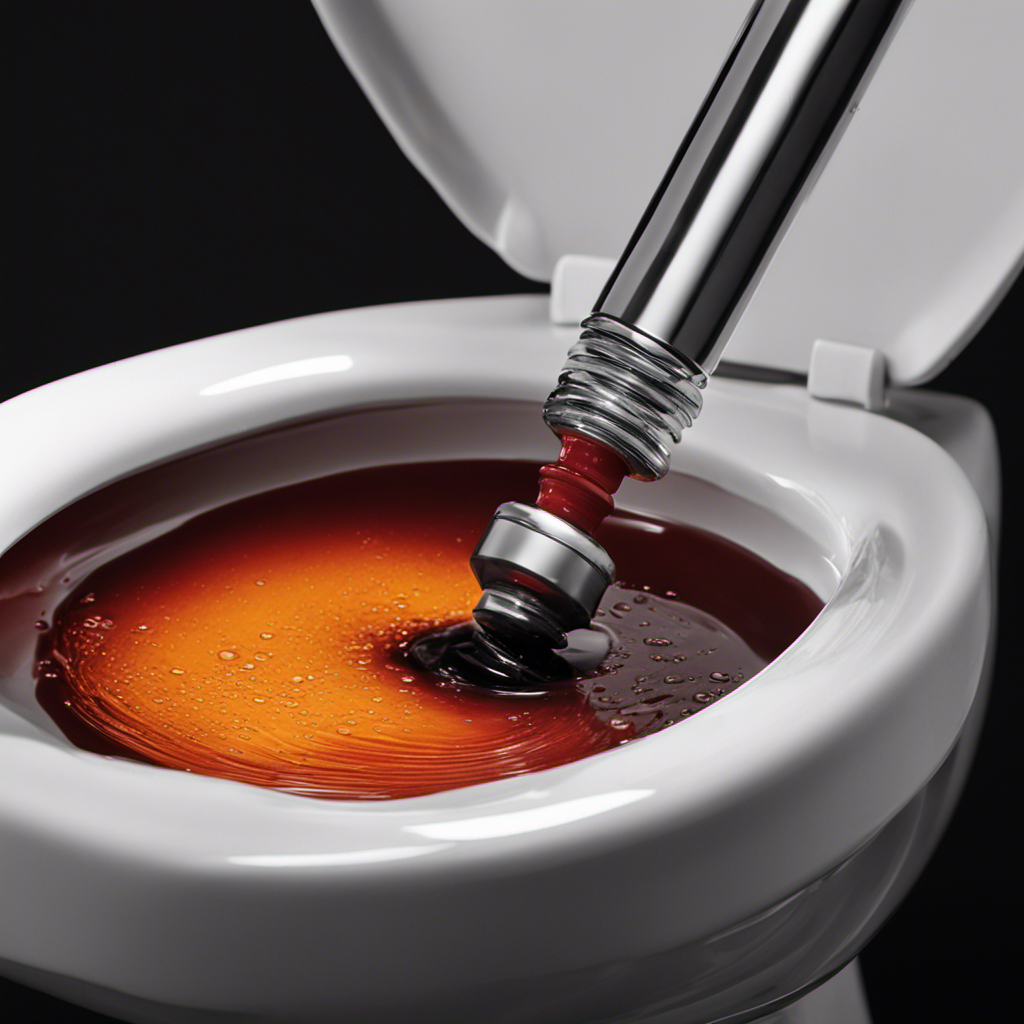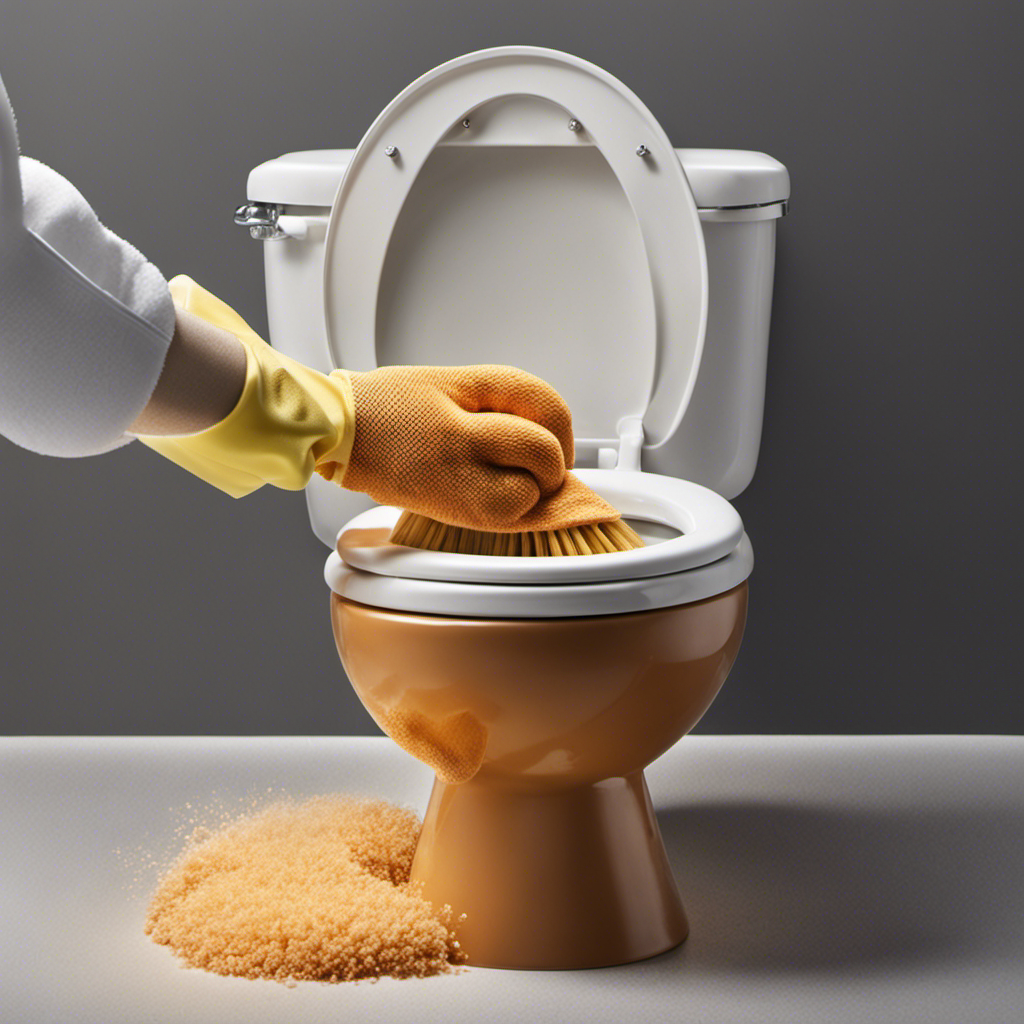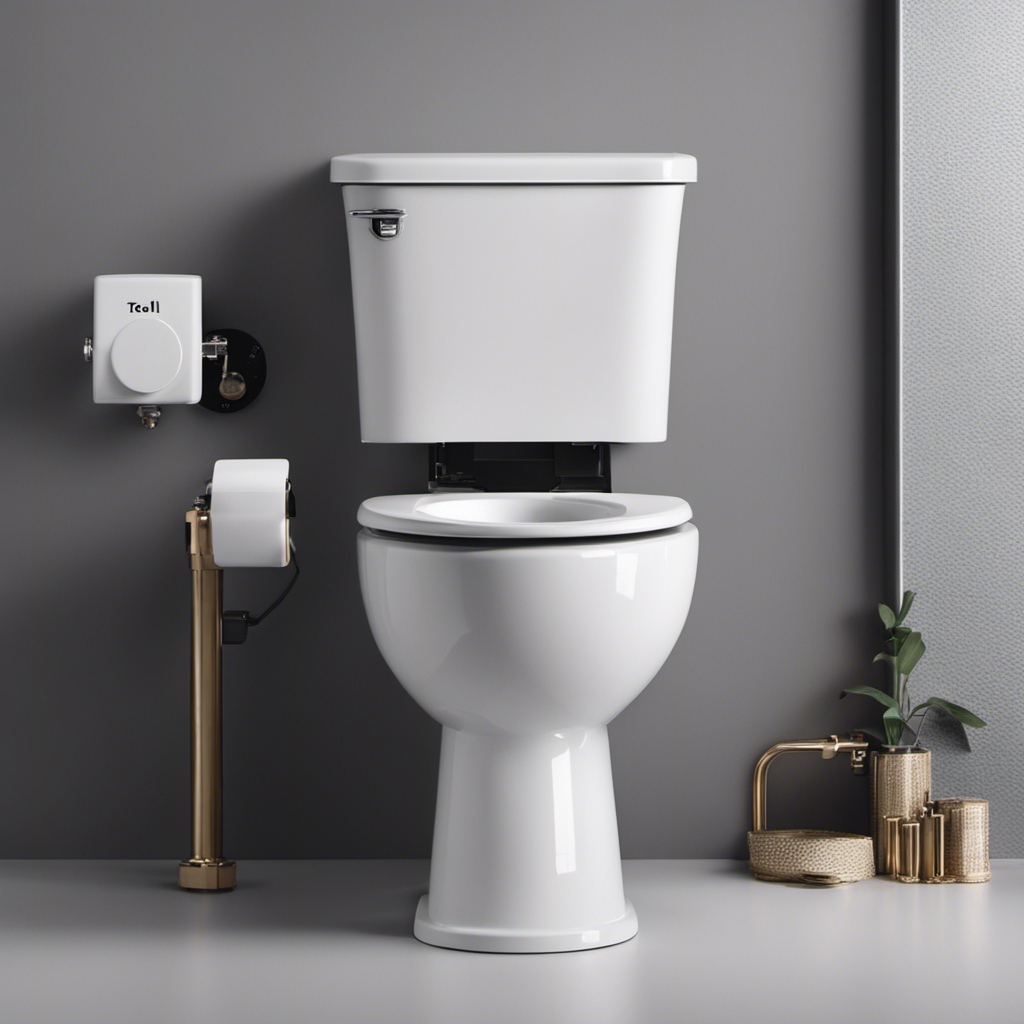Have you ever found yourself in a sticky situation with a clogged toilet? Don’t worry, I’ve got you covered.
In this article, I’ll share with you some tried and true techniques to help unclog your toilet and get things flowing smoothly again.
From common household tools to natural DIY solutions and even professional plumbing services, we’ll explore a range of options to tackle this pesky problem.
So, let’s dive in and discover what it takes to unclog a toilet with ease.
Key Takeaways
- DIY solutions for unclogging a toilet include using a wire coat hanger, vinegar and baking soda, hot water, and a plunger.
- It is important to exercise caution and avoid using excessive force to prevent damage to the toilet.
- Enzymatic cleaners are a non-toxic and environmentally friendly alternative to chemical drain cleaners.
- Hiring a professional plumber for toilet unclogging can ensure safety, save time, and provide long-term prevention of future clogs.
Common Household Tools
Common household tools can be used to help unclog a toilet. If you don’t have a plunger on hand, you can try using a wire coat hanger as an alternative. Straighten the hanger and create a small hook at one end. Insert the hooked end into the toilet drain and gently maneuver it to break up the clog. Remember to be cautious and avoid using excessive force to prevent any damage to the toilet.
When it comes to toilet brush maintenance, it’s important to regularly clean and disinfect the brush to prevent any buildup of bacteria or germs. I recommend using a mixture of hot water and bleach to soak the brush. After soaking, scrub it thoroughly before rinsing it off.
Natural DIY Solutions
When it comes to unclogging a toilet, there are a few natural DIY solutions that can be effective.
One popular method is using vinegar and baking soda. By pouring a cup of vinegar followed by a cup of baking soda into the toilet bowl, you create a chemical reaction that can help break down the clog.
Another method is the hot water technique, where you pour a pot of hot water into the toilet bowl to help loosen and dissolve the clog.
Lastly, the trusty plunger technique can also be used to unclog a toilet by creating suction and pushing the clog through the pipes.
Vinegar and Baking Soda
Using vinegar and baking soda is a popular method to unclog a toilet. This natural DIY solution can be a lifesaver when you have a toilet clog and want to avoid using harsh chemicals.
To begin, you’ll need one cup of baking soda and two cups of vinegar. First, pour the baking soda into the toilet bowl, making sure it reaches the bottom. Then, slowly pour the vinegar over the baking soda. You’ll immediately notice a fizzing reaction, which is a good sign that the solution is working.
Let the mixture sit for about 30 minutes to allow it to break down the clog. Afterward, flush the toilet to see if the clog has cleared. If necessary, you may need to repeat the process.
Hot Water Method
To clear a clog in your toilet, try the hot water method. This simple technique can often be effective in dislodging a stubborn blockage. Here’s how to do it:
-
Fill a large bucket with hot water. The water should be hot but not boiling, as boiling water can crack the porcelain of the toilet bowl.
-
Carefully pour the hot water into the toilet bowl. Aim for a height that allows the water to flow forcefully into the drain.
-
Wait for a few minutes to allow the hot water to work its magic. The heat will help to dissolve any organic matter causing the clog.
If the clog persists, you may need to try other methods such as using a toilet bowl cleaner or a toilet snake. These tools can help to break up and remove the blockage. Remember to always follow the instructions and exercise caution when using any plumbing tools.
Plunger Technique
The plunger technique is a common and effective method for clearing toilet clogs.
To prevent toilet clogs in the first place, it’s important to follow some toilet maintenance tips. First, avoid flushing anything other than toilet paper down the toilet. Items like paper towels, wipes, and feminine hygiene products can easily cause clogs.
Second, consider using less toilet paper to reduce the risk of clogging. Additionally, regular maintenance such as cleaning the toilet and checking for any signs of leaks or damage can help prevent clogs from occurring.
By taking these preventative measures, you can reduce the likelihood of dealing with a clogged toilet.
Now, let’s move on to discussing another option for unclogging toilets: chemical drain cleaners.
Chemical Drain Cleaners
Have you considered trying chemical drain cleaners to help unclog your toilet? While there are many options available, chemical alternatives such as enzymatic cleaners can be a powerful solution.
Here are four reasons why you should consider using enzymatic cleaners:
-
Effectiveness: Enzymatic cleaners contain specialized enzymes that break down organic waste, including toilet paper and waste buildup, effectively unclogging your toilet.
-
Safety: Unlike harsh chemical drain cleaners, enzymatic cleaners are non-toxic and environmentally friendly, making them a safer option for your home and the planet.
-
Preventive action: Regular use of enzymatic cleaners can help prevent future clogs by keeping your pipes clean and clear of debris.
-
Ease of use: Enzymatic cleaners are simple to use. Just pour the recommended amount into the toilet bowl, let it sit for the specified time, and then flush.
While chemical drain cleaners can be effective, they may not always be the best solution. If you prefer a more hands-on approach, let’s explore some plunger techniques to help unclog your toilet.
Plunger Techniques
If you’re struggling to fix a clogged toilet, give these plunger techniques a try. Plunger maintenance is essential for ensuring its effectiveness.
Start by checking the rubber suction cup for any cracks or tears. A damaged cup won’t create a proper seal and won’t be able to generate the necessary pressure. Clean the plunger after each use to prevent the buildup of bacteria and residue.
Now, let’s talk about alternative plunging methods. One technique is to use a toilet auger or snake. This tool allows you to reach deeper into the drain and remove stubborn blockages.
Another option is to use hot water and dish soap. Pour a bucket of hot water down the toilet, followed by a few squirts of dish soap. Let it sit for a few minutes, and then plunge as usual.
These alternative methods can be effective when traditional plunging doesn’t work.
Toilet Auger Usage
When it comes to using a toilet auger, it’s crucial to have proper technique in order to effectively clear a clog without causing any damage.
One key point to remember is to insert the auger into the toilet bowl slowly and carefully, ensuring it goes straight down and doesn’t scrape against the porcelain.
Additionally, it’s important to avoid using excessive force when turning the handle, as this can lead to potential damage to the toilet or even injury.
Proper Auger Technique
To properly use an auger, you’ll need to insert it into the toilet bowl and rotate the handle in a clockwise motion. Here are four key steps to effectively use a toilet auger:
-
Insert the auger into the toilet bowl until you feel resistance. This indicates that the auger has reached the clog.
-
Rotate the handle in a clockwise motion to break up the blockage. Apply steady pressure but avoid using excessive force to prevent any potential damage to the toilet.
-
Continue rotating the auger until you feel the clog loosening. You may also feel a sudden release as the clog breaks apart.
-
Slowly withdraw the auger from the toilet bowl, being careful not to let any debris fall back into the drain.
Avoiding Potential Damage
To prevent potential damage, it’s essential to apply steady pressure while rotating the auger. This technique helps to avoid long-term consequences and potential health hazards. When using an auger, it’s important to keep in mind that excessive force can cause damage to the toilet bowl or pipe. By applying steady pressure, you can effectively break up the clog without causing any further harm.
Here is a table that illustrates the potential consequences and health hazards of using too much force while unclogging a toilet:
| Potential Consequences | Potential Health Hazards |
|---|---|
| Cracked toilet bowl | Exposure to harmful bacteria |
| Damaged pipes | Inhalation of toxic fumes |
| Leaks | Risk of injury |
| Costly repairs | Spread of germs |
Professional Plumbing Services
Hiring a professional plumber can quickly resolve any issues with a clogged toilet. Their professional expertise and cost-effective solutions are invaluable. Here are four reasons why hiring a professional plumber is the best choice:
-
Experience: Professional plumbers have extensive experience in dealing with all kinds of toilet clogs. They know the right techniques and tools to use to unclog your toilet efficiently.
-
Safety: Unclogging a toilet can be a messy and potentially hazardous task. Professional plumbers have the necessary skills and equipment to handle the job safely, minimizing the risk of injury or damage to your property.
-
Time-saving: Trying to unclog a toilet yourself can be time-consuming and frustrating. Professional plumbers can quickly diagnose the problem and resolve it in a timely manner, saving you valuable time and effort.
-
Long-term solutions: While DIY methods may provide temporary relief, professional plumbers offer long-term solutions that address the root cause of the clog, preventing future issues and saving you money in the long run.
Preventative Maintenance Tips
Regularly maintaining your plumbing system is essential to prevent future issues and ensure its optimal functionality. One common problem that homeowners face is a clogged toilet. Understanding the causes of toilet clogs and recognizing the signs can help you take proactive measures to avoid this inconvenience.
Several factors can lead to a clogged toilet, including flushing excessive amounts of toilet paper, foreign objects accidentally dropped inside, or a build-up of debris in the pipes. Signs of a clogged toilet include water rising to the brim when flushing, slow drainage, gurgling sounds, or a foul odor emanating from the bowl.
To prevent toilet clogs, it is important to flush only appropriate waste and avoid flushing items that are not meant to be disposed of in a toilet. Regularly using a plunger or a plumbing snake can also help prevent blockages.
Conclusion
In conclusion, when faced with a clogged toilet, there are various options available to unclog it. From using common household tools like a plunger or toilet auger to trying natural DIY solutions or chemical drain cleaners, there are solutions for every situation.
However, if all else fails, it may be best to call in professional plumbing services. Remember, regular preventative maintenance is key to avoiding future clogs.
Don’t let a clogged toilet ruin your day – take action and flush away those worries!










